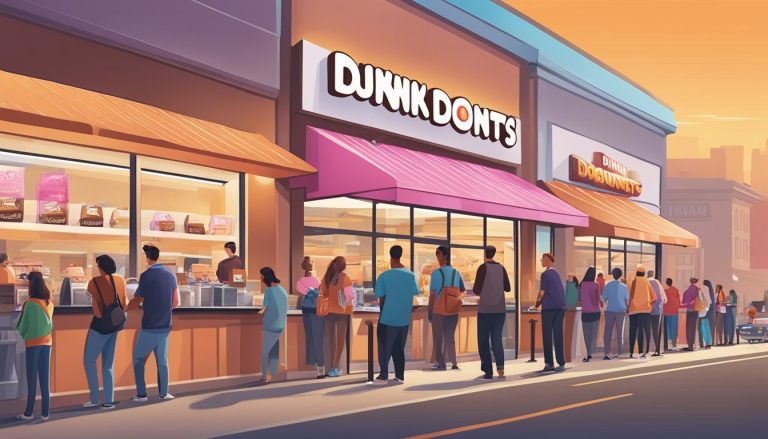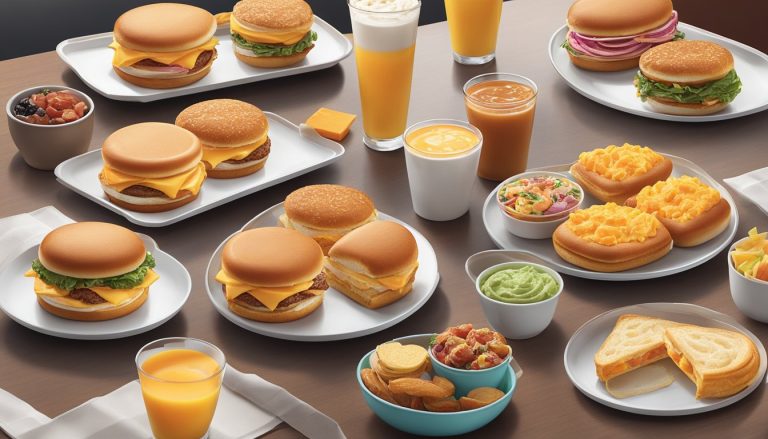Dunkin’ has come a long way from its humble beginnings as a donut shop. The brand has evolved to become a major player in the fast-food breakfast market, with a strong focus on coffee and an expanding menu. As consumer preferences shift and technology advances, Dunkin’ is poised to make significant changes to its breakfast offerings in the coming years.
By 2025, Dunkin’ plans to source all of its coffee ethically through its Drive-To Sustainability Program. This commitment reflects a growing trend among consumers who prioritize sustainable and responsibly sourced products. Beyond coffee, Dunkin’ is likely to continue expanding its menu to cater to changing tastes and dietary preferences.
The brand’s recent introduction of breakfast tacos signals a willingness to experiment with new items beyond its traditional fare of donuts and breakfast sandwiches. This diversification strategy aims to attract a broader customer base, including younger generations like Gen Z, who are increasingly important to the fast-food breakfast market. As Dunkin’ looks to the future, it will need to balance innovation with maintaining its core brand identity that customers have come to know and love.
The Evolution of Dunkin’s Breakfast

Dunkin’ has transformed its breakfast offerings to meet changing consumer demands and market trends. The company has expanded beyond its donut-centric roots to become a versatile breakfast destination.
Adapting to Consumer Preferences
Dunkin’ recognized the shift in breakfast habits and responded accordingly. The company expanded its menu to include healthier options and more diverse flavors. Whole grain wraps, egg white sandwiches, and plant-based alternatives now feature prominently alongside traditional fare.
Dunkin’ also introduced customization options, allowing customers to tailor their breakfast to their specific tastes and dietary needs. This flexibility has helped the brand appeal to a wider audience, from health-conscious millennials to busy professionals seeking quick, satisfying meals.
The introduction of all-day breakfast items further catered to evolving consumer lifestyles. This move acknowledged that traditional breakfast hours no longer apply to many customers’ schedules.
Expanding the Breakfast Menu
Dunkin’s breakfast menu has grown significantly beyond donuts and coffee. The company now offers a range of breakfast sandwiches, featuring various breads, proteins, and toppings. These options include:
- Classic bacon, egg, and cheese on a bagel
- Turkey sausage on an English muffin
- Veggie egg white on a multigrain thin
Savory wraps and bowls have also been added to the lineup, providing more substantial meal options. Dunkin’ introduced oatmeal and yogurt parfaits to cater to health-conscious customers.
Beverage options expanded as well. Alongside traditional coffee, Dunkin’ now serves specialty lattes, cold brews, and fruit-infused energy drinks. These additions have positioned Dunkin’ as a competitor in the premium beverage market.
Sustainability Initiatives
Dunkin’ has integrated sustainability into its breakfast evolution. The company has committed to sourcing 100% of its coffee from Rainforest Alliance Certified™ farms by 2025. This initiative ensures ethical sourcing and supports environmentally friendly farming practices.
Packaging improvements have also been a focus. Dunkin’ has pledged to eliminate foam cups, replacing them with double-walled paper cups. The company is exploring compostable and recyclable alternatives for other packaging materials.
Dunkin’ has also introduced plant-based options to reduce its environmental impact. The Beyond Sausage Breakfast Sandwich, made with plant-based protein, exemplifies this commitment to sustainability and diverse menu offerings.
Innovation and Technology

Dunkin’ is embracing technological advancements to enhance customer experience and streamline operations. The company is focusing on mobile solutions, loyalty programs, and product innovations to stay competitive in the evolving breakfast market.
Mobile Ordering and Drive-Thru Enhancements
Dunkin’s mobile app is revolutionizing how customers interact with the brand. The app allows for quick, convenient ordering and payment, reducing wait times and improving customer satisfaction. Drive-thru experiences are being upgraded with digital menu boards and automated order verification systems.
These innovations aim to speed up service and reduce errors. Dunkin’ is also testing AI-powered voice ordering systems at drive-thrus in select locations. This technology could significantly cut down order times and improve accuracy.
Loyalty Program Evolution
The DD Perks loyalty program is undergoing a digital transformation. Dunkin’ is incorporating personalized offers based on customer preferences and purchase history. Members can now earn points through various channels, including in-store purchases, mobile orders, and even by buying Dunkin’ products at grocery stores.
The program is expanding to include gamification elements, encouraging more frequent visits and increased spending. Dunkin’ is also exploring partnerships with other brands to offer cross-promotional rewards, further enhancing the value proposition for loyalty members.
Ready-to-Drink Bottled Iced Coffee
Dunkin’ is capitalizing on the growing demand for convenient, on-the-go coffee options. The company has expanded its line of ready-to-drink bottled iced coffees, available in grocery stores and convenience stores nationwide. These products come in various flavors, catering to different taste preferences.
Dunkin’ is investing in new packaging technologies to extend shelf life and maintain product quality. The brand is also exploring sustainable packaging options to appeal to environmentally conscious consumers. This expansion into retail channels allows Dunkin’ to reach customers beyond their traditional restaurant locations.
Competition and Market Dynamics

Dunkin’ faces fierce competition in the breakfast and coffee market, with major players vying for market share. The company must continually adapt its strategies to stay competitive and meet changing consumer preferences.
Comparison with Starbucks
Dunkin’ and Starbucks remain the two dominant forces in the coffee and breakfast market. Dunkin’ positions itself as a more affordable, faster option compared to Starbucks’ premium, sit-down experience. Dunkin’ has a stronger presence in the northeastern United States, while Starbucks maintains a larger global footprint.
In terms of menu offerings, Dunkin’ focuses on simpler coffee drinks and a wider variety of food items. Starbucks, on the other hand, emphasizes specialty coffee beverages and a more limited food selection.
Dunkin’ has been expanding its espresso-based drink offerings to compete more directly with Starbucks in this growing market segment.
Adopting to Changing Market Share
Dunkin’ has been working to maintain and grow its market share in a rapidly evolving industry. The company has focused on expanding into new geographic markets, particularly in the western United States and internationally.
To appeal to younger consumers, Dunkin’ has introduced more plant-based options and healthier menu items. The company has also invested in mobile ordering and delivery services to meet the increasing demand for convenience.
Dunkin’ has rebranded itself, dropping “Donuts” from its name to emphasize its broader menu offerings beyond just donuts and coffee.
Marketing Strategies and Campaigns
Dunkin’ employs various marketing strategies to maintain its competitive edge. The company’s “America Runs on Dunkin'” slogan has been a cornerstone of its brand identity, emphasizing speed and convenience.
Social media plays a crucial role in Dunkin’s marketing efforts. The brand actively engages with customers on platforms like Twitter and Instagram, often using humor and trending topics to connect with younger audiences.
Dunkin’ frequently introduces limited-time offerings and seasonal menu items to generate buzz and drive customer traffic. These promotions are heavily marketed across various channels, including television, radio, and digital platforms.
The company has also partnered with influencers and celebrities to boost brand visibility and appeal to different demographic groups.
Dunkin’s Business Strategy and Financial Health

Dunkin’ has built its success on a franchised business model and strategic expansion. The company’s financial performance reflects its growth trajectory and resilience in the face of challenges.
Exploring Dunkin’s Business Model
Dunkin’ operates under a 100% franchised model, which offers financial and strategic advantages. This approach allows for rapid expansion while minimizing capital expenditure. The company has over 21,000 distribution points across more than 60 countries, showcasing its global reach.
Dunkin’s franchise strategy proved robust during the COVID-19 pandemic, helping the company weather economic disruptions better than some competitors. The model provides a steady revenue stream through franchise fees and royalties.
Analyzing Systemwide Sales and Profitability
Dunkin’s systemwide sales have shown growth over the years, though the pandemic caused setbacks. In 2020, same-store sales decreased by 18.7% in the second quarter due to COVID-19 impacts.
The company’s profitability is tied to its franchise model, which typically yields higher profit margins compared to company-owned stores. However, Dunkin’ faced challenges in recent years:
- Closure of 800 U.S. stores during the pandemic
- Limited ability to invest in new products and marketing due to financial constraints
- Pressure on same-store sales growth in a competitive market
Despite these hurdles, Dunkin’s community-centric strategies and focus on coffee sustainability initiatives aim to strengthen its market position and financial health.
Customer Loyalty and Brand Engagement
Dunkin’ has consistently focused on building strong relationships with its customers through targeted strategies and innovative approaches. The brand’s efforts in enhancing customer experience, strengthening loyalty, and leveraging social media have played crucial roles in maintaining its competitive edge.
Enhancing Customer Experience
Dunkin’ prioritizes creating positive interactions at every touchpoint. The brand has invested in mobile ordering technology, allowing customers to skip lines and customize orders easily. In-store experiences have been upgraded with modern designs and efficient service processes. Menu innovations cater to changing consumer preferences, introducing healthier options and seasonal specialties. Dunkin’ also emphasizes staff training to ensure friendly and prompt service, contributing to overall customer satisfaction.
Affordability remains a key factor in Dunkin’s appeal. The brand offers competitive pricing and frequent promotions to provide value to cost-conscious consumers.
Strengthening Brand Loyalty
The DD Perks Rewards program forms the cornerstone of Dunkin’s loyalty strategy. Members earn points on purchases, redeemable for free beverages and food items. Personalized offers based on customer preferences and purchase history encourage repeat visits and increase engagement.
Dunkin’ regularly introduces limited-time promotions to generate excitement and drive sales. These include seasonal menu items, holiday-themed campaigns, and collaborative partnerships with popular brands or celebrities.
The brand also focuses on community involvement, sponsoring local events and supporting charitable causes. This approach helps foster emotional connections with customers beyond transactional relationships.
Utilizing Social Media
Dunkin’ leverages various social media platforms to engage with customers and build brand awareness. The company maintains active profiles on Instagram, Twitter, and Facebook, sharing visually appealing content and responding promptly to customer inquiries.
User-generated content campaigns encourage customers to share their Dunkin’ experiences, creating authentic brand advocacy. The brand also collaborates with influencers to reach new audiences and reinforce its relevance in popular culture.
Social media serves as a platform for announcing new products, promotions, and initiatives. Dunkin’ uses these channels to gather customer feedback, conduct polls, and stay attuned to consumer preferences and trends.
Emerging Trends and the Road Ahead

Dunkin’ is poised to navigate the evolving quick-service landscape while appealing to a new generation of coffee lovers. The company’s future hinges on strategic adaptations and innovative offerings.
Adapting to the Quick Service Landscape
Dunkin’ is embracing technology to streamline operations and enhance customer experience. Mobile ordering and payment options are becoming increasingly sophisticated. The company is investing in AI-powered drive-thru systems to reduce wait times and improve order accuracy.
Dunkin’ is also exploring automation in food preparation. Robotic coffee makers and assembly lines for sandwiches may become commonplace in stores. These innovations could significantly cut labor costs and boost efficiency.
The brand is expanding its plant-based menu items to cater to health-conscious consumers. Oat milk lattes and vegan protein bites are just the beginning of this trend.
Catering to the Next Generation
Millennials and Gen Z are reshaping Dunkin’s approach to product development and marketing. The company is focusing on bold, Instagram-worthy beverages and snacks to appeal to younger consumers.
Dunkin’ is experimenting with trendy flavor combinations and limited-time offers to create buzz. Cold brew innovations, such as nitro-infused options and flavored cold foams, are gaining traction.
The brand is also refining its pricing strategy to attract budget-conscious young adults. Value menus and subscription-based coffee plans are being tested in select markets.
Sustainability initiatives are becoming a key focus. Dunkin’ is transitioning to eco-friendly packaging and sourcing more ethically produced coffee beans to resonate with environmentally conscious customers.
Menu Innovation and New Offerings
Dunkin’ continues to push the boundaries of breakfast with creative twists on classics and entirely new menu items. The chain aims to balance familiar favorites with exciting innovations to keep customers engaged.
Creative Takes on Classic Favorites
Dunkin’ reimagines its iconic bagels with new flavor combinations like everything seasoning and jalapeno cheddar. The chain experiments with donut fries, transforming the classic pastry into a portable, dippable treat. Pretzel bites offer a savory alternative, perfect for on-the-go snacking.
These updated classics cater to evolving taste preferences while maintaining Dunkin’s signature style. The brand also explores healthier versions of fan favorites, incorporating whole grains and reducing sugar content where possible.
Experiments with New Breakfast Items
Dunkin’ ventures into uncharted breakfast territory with innovative offerings. The chain introduces protein-packed breakfast bowls featuring quinoa, eggs, and roasted vegetables. Plant-based options like Beyond Sausage breakfast sandwiches appeal to health-conscious consumers.
Seasonal limited-time offerings keep the menu fresh and exciting. Dunkin’ tests global breakfast inspirations, such as breakfast empanadas and churro-inspired pastries. These new items aim to attract diverse customer segments and broaden Dunkin’s appeal beyond traditional coffee and donuts.




